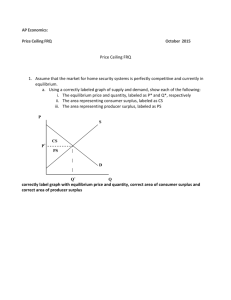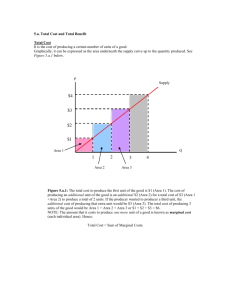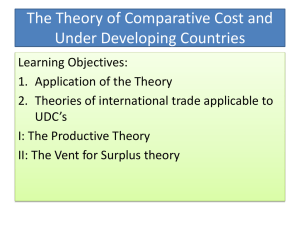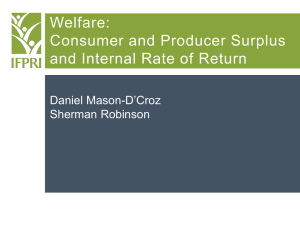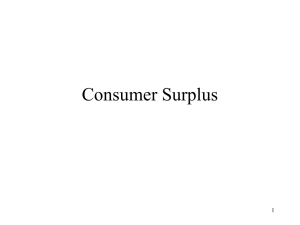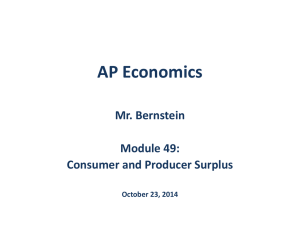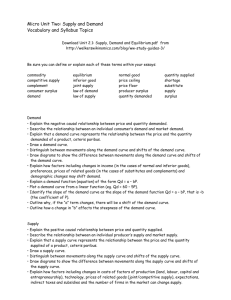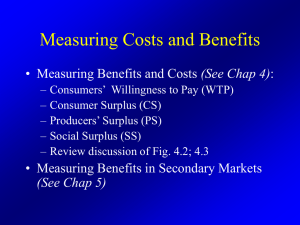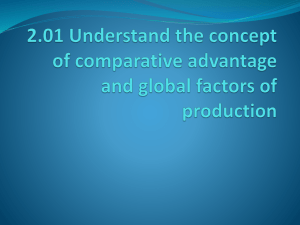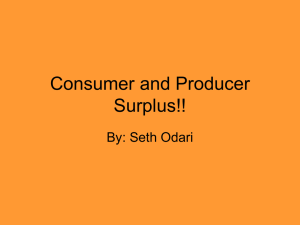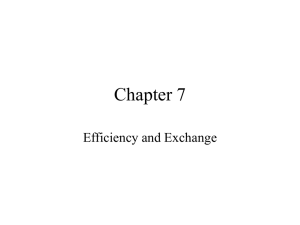Class Room Experiment
advertisement
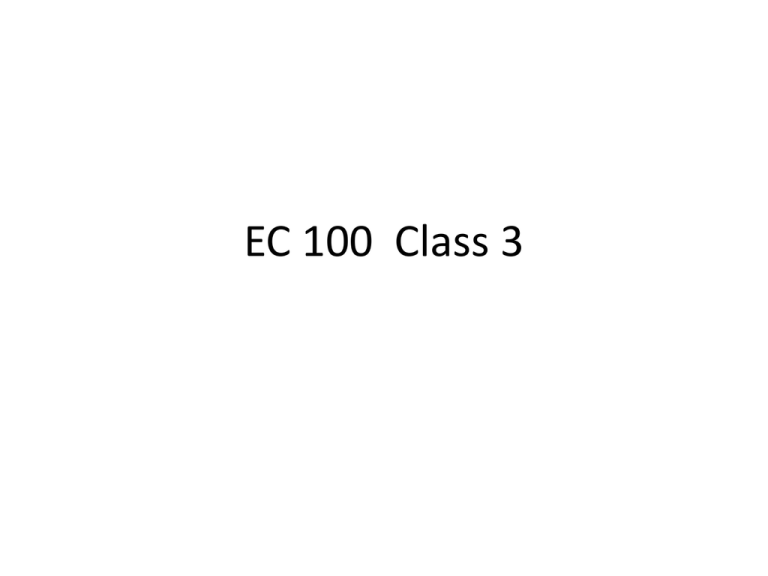
EC 100 Class 3 Question 1 • A consumer values the first unit of a good they consume at £10, the second at £8, the third at £6 and the fourth at £5. If the price of the good is £7 how many units of the good do they buy? Question 1 and 2 • A consumer values the first unit of a good they consume at £10, the second at £8, the third at £6 and the fourth at £5. If the price of the good is £7 how many units of the good do they buy? • Gains from first unit: 10-7 =3 > 0 • Gains from second unit: 8-7 = 1 >0 • Gains from third unit: 6 – 7<0 – so better off not purchasing third unit • So total surplus to consumer = 3 + 1 = 4 Question 3 • Supply curve reflects the sellers marginal cost – each unit sold at marginal cost covers only cost of producing this unit. • Hence producers do not earn anything on the “marginal unit” sold. • If the supply curve is horizontal, all “inframarginal” units are sold at marginal cost as well. Question 3 • Extreme Cases of Horizontal Supply – Producer surplus = 0. Price ,P Equilibrium price Supply Curve Demand = Willingness to pay Q * 1 Quantity, Question 4 • Downward shift in supply curve: price sold is still = MC for all inframarginal units. So producer surplus = 0, only consumers benefit. Price ,P Supply Curve Equilibrium price Demand Q * 1 Quantity, Question 5 • Absolute advantage: country is the lowest cost producer of that good. • Comparative advantage: country makes the good relatively cheaper than other goods. – Country has a lower opportunity cost for producing the good • Law of comparative advantage: countries should specialize in production of the good(s) for which they have a comparative advantage. – This produces higher overall output (to be shared between countries) – Country always has a comparative advantage in something – (Free market provides right incentives for this to happen – no government involvement necessary) Question 5 Question 6 • Suppose a country is in the unfortunate position of not having an absolute advantage in the production of any good. Tick all of the following statements that must then be true Question 7 • Another example… • A person in China can produce 100kg of rice in a year or 10 litres of olive oil (or a combination of the two). A person in Italy can produce 25kg of rice in a year or 50 litres of olive oil (or a combination of the two). Which of the following statements are true Question 7 • Absolute advantages: Italy has absolute advantage to produce Oil, while China has absolute advantage to produce rice. • Comparative advantage: Italy has comparative advantage in olive oil, China has comparative advantage in rice. • So: – Italy should specialize in olive oil (and export to China for rice…) – China should specialize in rice (and export to Italy for olive oil…) Studying Policy intervention • A key part of this course is for you to be able to understand the impacts of different policy interventions • Or to have the tools to analyze the effects of policy interventions in a simple framework of supply and demand. • Very common interventions: taxes, subsidies, price regulation… Question 9 • The house rental market is perfectly competitive but renting a house is expensive so the government decides to impose a ceiling on rents that is below the market-clearing price. What will happen to the amount of housing in the market? Question 9 • Now there is excess demand Price Ceiling New Q Question 10 • Some PS becomes CS – overall surplus falls (brown area is DWL) Price Ceiling New Q Question 11 • What about consumer surplus? … it depends Loose this Gain this Price Ceiling New Q Question 11 • What about consumer surplus? … it depends • The crucial factor is the steepness of the supply curve… • If supply very elastic – flat supply curve – quantity falls sharply after price ceiling • DWL very high Question 12 • What about producer surplus? … it goes down • Intuition: • Profits = (P-AC)*Q – Prices and quantity both fall so firms are losing out Question 12 • What about producer surplus? … it goes down Price Ceiling New Q Discussion Question – Payday Lending • To repay a £400 loan for 45 days costs £588 which works out as an annualized rate of interest of 5000 per cent per year. • People can take out mortgages right now (if eligible) at an interest rate of less than 4 per cent per year. The interest rates charged are exploitative and Wonga should be banned? • Key point: probably not the same people… • People choose to use Wonga, so they must be better off – Good argument against banning Wonga – Assuming people know what is best for them… – Government bans drugs, smoking (<18) etc so why not Wonga? The interest rates charged are exploitative and so rates should be capped. • See question 12 – effect on consumer surplus is ambiguous • Some people lose out – can no longer get a loan. • Is market for loans perfectly competitive? – If so, interest rates represent cost of providing loans – If barriers to entry, scope for government involvement (see monopoly topics…) Wonga should be allowed but the interest rates it charges should be capped. • Interest rate caps may not solve the problem, as it means that some loans are not granted that would have been granted otherwise. • The people who do not get the loans are worse off. • Who are the people using this service? Why are they using this? Is there some other inherent market failure that may drive this?
